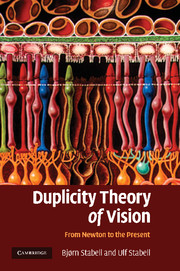Book contents
- Frontmatter
- Contents
- Acknowledgements
- 1 Introduction
- Part I The development of the basic ideas of the duplicity theory from Newton to G. E. Müller
- 2 The Newton tradition
- 3 The Schultze tradition
- 4 The Goethe tradition: the phenomenological approach
- 5 The colour theories of Armin Tschermak and George Elias Müller
- Part II The development of the duplicity theory from 1930–1966
- Part III Chromatic rod vision: a historical account
- Part IV Theories of sensitivity regulation of the rod and cone systems: a historical account
- Part V Factors that triggered the paradigm shifts in the development of the duplicity theory
- References
- Index
3 - The Schultze tradition
Published online by Cambridge University Press: 22 January 2010
- Frontmatter
- Contents
- Acknowledgements
- 1 Introduction
- Part I The development of the basic ideas of the duplicity theory from Newton to G. E. Müller
- 2 The Newton tradition
- 3 The Schultze tradition
- 4 The Goethe tradition: the phenomenological approach
- 5 The colour theories of Armin Tschermak and George Elias Müller
- Part II The development of the duplicity theory from 1930–1966
- Part III Chromatic rod vision: a historical account
- Part IV Theories of sensitivity regulation of the rod and cone systems: a historical account
- Part V Factors that triggered the paradigm shifts in the development of the duplicity theory
- References
- Index
Summary
THE DUPLICITY THEORY OF MAX SCHULTZE
The first section of Helmholtz's classical ‘Handbuch der Physiologischen Optik’ was published in 1856, the second (containing the Young-Helmholtz trichromatic colour theory) in 1860, the third partly at the beginning and partly towards the close of 1866, while the complete work was published in 1867. The Young-Helmholtz colour theory was, therefore, known to Max Schultze (professor in anatomy and the director of the Anatomic Institute in Bonn, Germany) when he published his important work in 1866. Indeed, he accepted its major assumption that three different cone fibres conveyed independent, qualitatively different colour-related processes.
Yet, in addition to the cone receptors and their functions, he introduced the much more numerous rod receptors presuming that they were responsible for night vision, and that they mediated achromatic sensation only. This theory of Schultze may be seen as the third major paradigm shift in vision research. It entailed a profound new insight into visual processing and generated basic questions about differences and similarities as well as about possible interactions between the information processing of the two different receptor systems.
EVIDENCE IN FAVOUR OF THE THEORY
Schultze's hypothesis that the retina contained two basically different kinds of receptor was based on extensive, comparative histological studies. Although he was aware of the fact that the structure of a receptor type in different species, and even in the same retina, may differ markedly, he found rods and cones in general to differ both with respect to structure and occurrence.
- Type
- Chapter
- Information
- Duplicity Theory of VisionFrom Newton to the Present, pp. 22 - 40Publisher: Cambridge University PressPrint publication year: 2009



